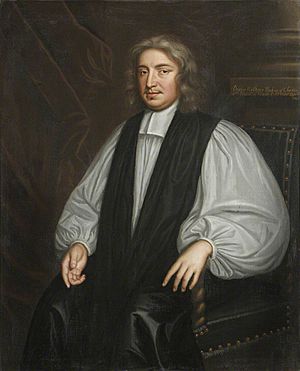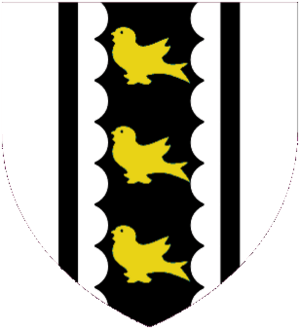John Wilkins facts for kids
Quick facts for kids The Right Reverend John Wilkins FRS |
|
|---|---|
| Bishop of Chester | |
 |
|
| Diocese | Diocese of Chester |
| In Office | 1668–1672 (death) |
| Predecessor | George Hall |
| Successor | John Pearson |
| Other posts | Dean of Ripon (1663–1672) |
| Personal details | |
| Born | 14 February 1614 Fawsley, Northamptonshire |
| Died | 19 November 1672 (aged 58) Chancery Lane, London |
| Buried | St Lawrence Jewry, London |
| Nationality | English |
| Denomination | Anglican |
| Spouse | Robina Cromwell (m.1656) |
| Profession | Clergyman, natural philosopher, author, administrator |
| Alma mater | New Inn Hall, Oxford Magdalen Hall, Oxford |
John Wilkins (born February 14, 1614 – died November 19, 1672) was an Anglican clergyman, a natural philosopher (meaning someone who studied nature and the universe), and an author. He was one of the people who helped start the famous Royal Society, a group dedicated to science. From 1668 until he passed away, he was the Bishop of Chester.
Wilkins was a very smart person who knew a lot about many different subjects, often called a polymath. He was one of the few people to lead a college at both the University of Oxford and the University of Cambridge. He was known for being able to calm political arguments during a difficult time in England. He also helped create the Royal Society as a place where people from all backgrounds could work together on science. He is especially remembered for his book An Essay towards a Real Character and a Philosophical Language (1668). In this book, he suggested a universal language and a system for measuring things, similar to the metric system we use today.
Wilkins lived during a time of big changes and disagreements in politics and religion in England. Despite this, he managed to get along with people from all sides. He played a key role in trying to make the Church of England more welcoming to different Protestant groups. People who knew him said he was very kind and always tried to do good.
Contents
Early Life and Education
John Wilkins was likely born in Canons Ashby, Northamptonshire, England. His father, Walter Wilkins, was a goldsmith, and his mother, Jane Dod, was the daughter of a well-known religious leader.
He went to school in Oxford and later studied at New Inn Hall and Magdalen Hall at the University of Oxford. He earned his first degree in 1631 and a master's degree in 1634. He also studied astronomy.
In 1638, Wilkins became a priest in the Church of England. He then worked as a chaplain (a religious advisor) for important people like Lord Saye and Sele and Lord Berkeley. By 1644, he was chaplain to Prince Charles Louis, who was the nephew of King Charles I.
A Leader in Science and Learning
In 1646, Wilkins joined a group of smart people in London who were interested in "experimental philosophy," which was how they described early science. This group included important thinkers like John Wallis. They often met to discuss new ideas and experiments. This group was an early step towards forming the Royal Society.
In 1648, Wilkins became the leader, or Warden of Wadham College, at Oxford. Under his leadership, the college became very successful. He encouraged people to be tolerant of different political and religious views. He also attracted many talented students and scholars, including the famous architect Christopher Wren. Even though he supported Oliver Cromwell, who was a powerful leader at the time, families who supported the King still sent their sons to his college.
Wilkins brought together a group of scientists at Oxford, known as the Oxford Philosophical Club. This group included famous scientists like Robert Boyle and Robert Hooke. They met regularly to share their scientific discoveries and ideas.
In 1656, Wilkins married Robina French, who was the youngest sister of Oliver Cromwell. This marriage connected him to a very important family in England. Shortly before Cromwell's death, Wilkins was given a new job as the Master of Trinity College, Cambridge. He became a mentor to the mathematician Isaac Barrow there.
After the King Returned
When the King returned to power in 1660 (an event called the Restoration), Wilkins lost the position that Cromwell had given him. However, he soon found new roles as a church leader in different parts of England.
In 1662, he became the vicar of St Lawrence Jewry in London. Sadly, he lost his home, his library, and his scientific tools in the terrible Great Fire of London.
Wilkins was very interested in science, so he became a founding member of the Royal Society. He was quickly chosen as one of the Society's two secretaries, working alongside Henry Oldenburg.
Becoming a Bishop
In 1668, John Wilkins became the Bishop of Chester. He got this important job thanks to the influence of a powerful person, the Duke of Buckingham. Wilkins and Buckingham both believed in "comprehension." This idea meant trying to bring different Protestant groups, especially the Presbyterians, back into the Church of England through peaceful talks and agreements.
As a bishop, Wilkins spoke out against harsh laws that punished people for their religious beliefs. He immediately tried to get other moderate bishops to agree to make some changes to welcome nonconformists (Protestants who did not follow the Church of England's rules).
In 1668, a serious effort was made to create a plan for comprehension. Wilkins met with leaders from different Protestant groups. Wilkins believed that Presbyterians could be brought into the Church of England, even if other groups remained separate. However, these efforts did not succeed that year.
Death
John Wilkins passed away in London in 1672. It is believed that his death was caused by the medicines he was taking to treat his kidney stones and other health issues.
Key Works and Ideas
Wilkins wrote many books and papers. His early scientific writings were very popular and often explored exciting new ideas.
- The Discovery of a World in the Moone (1638): In this book, Wilkins discussed the Moon and suggested that it might be similar to Earth and could even have living beings on it.
- A Discourse Concerning a New Planet (1640): This book continued his ideas about other worlds.
- Mercury, or the Secret and Swift Messenger (1641): This was the first English book about cryptography, which is the art of writing and solving secret codes.
- Mathematical Magick (1648): This book explored mechanical devices like levers and also imagined more advanced machines. It even talked about the possibility of flying machines powered by birds!
- Ecclesiastes (1646): This book was about how preachers should speak. Wilkins argued for a clear and simple style of preaching, rather than using complicated language.
- A Discourse Concerning the Beauty of Providence (1649): In this work, Wilkins suggested that God's plans are often mysterious and hard for people to understand.
- Vindiciae academiarum (1654): Wilkins wrote this with Seth Ward to defend the universities of Oxford and Cambridge. They argued that the universities were not stuck in old ways but were open to new scientific ideas.
- An Essay towards a Real Character, and a Philosophical Language (1668): This is one of his most famous works. In it, he tried to create a completely new, universal language that would be clear and easy for scholars and scientists to use. He also suggested a new system of measurement, similar to the metric system.
His works were often imaginative and sometimes included ideas that seemed a bit magical or futuristic for his time. He was a true visionary who believed in the power of science and clear communication.
Images for kids
See also
 In Spanish: John Wilkins para niños
In Spanish: John Wilkins para niños
- The Analytical Language of John Wilkins (an essay by Jorge Luis Borges)





